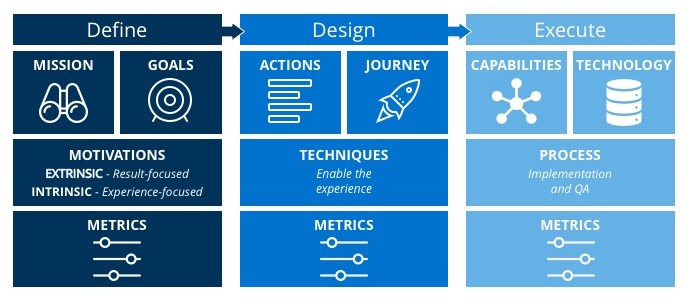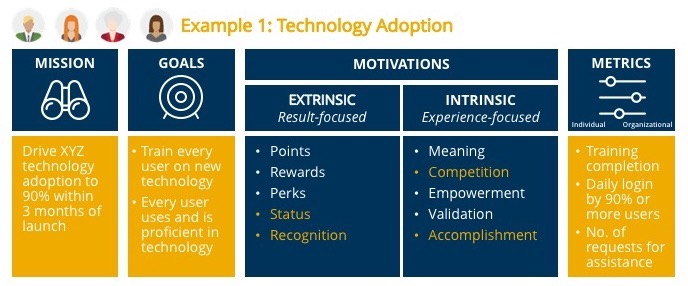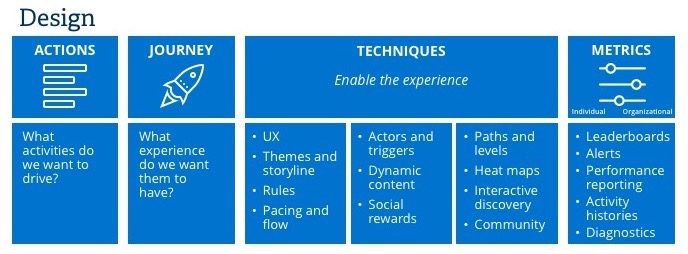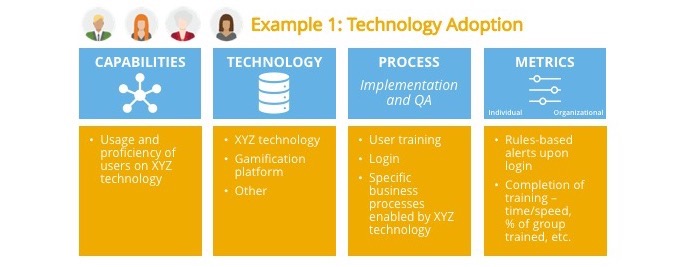Sales and Marketing Technology Adoption Isn’t a Game. Or Is It?
- Among methods for training sales reps, gamification scored low in a recent SiriusDecisions study
- Sales and marketing technology adoption continues to puzzle many sales and marketing operations leaders
- When using gamification for tech adoption, follow a structured approach of define, design and execute
At SiriusDecisions, we see B2B sales organizations using gamification for onboarding and training as well as sales performance – via specific short-term initiatives and desired behavior changes. It typically isn’t used to increase the usage or adoption of a given technology. Why? Well, because gamification has not lived up to the hype as a strategy for tech adoption. But whether this is due to a malfunction of the gamification software, poor game design and rollout, or poor technology implementation in general remains to be seen.
In SiriusDecisions’ 2018 Sales Talent Study, respondents were asked the following question: “When considering how you learn most effectively, what are your top three training delivery preferences?” The answer “gamification (learning in a scored competitive environment)” scored 14th out of 15 choices, beating out only … podcasts.
Gamification applies elements of game playing (e.g. point scoring, winning, rules of play) to engage employees (typically sales) and encourage specific expectations. It’s a tactic that can be used to drive behavior, but it’s not always the strongest one – game design is a key factor in success. Communication, proof of value (to the user), onboarding and ongoing training are all required. For these reasons, SiriusDecisions typically doesn’t recommend using gamification as the sole tactic with which to train sales reps or facilitate adoption of a new technology.
That said, the concepts of gamification – or game mechanics – can be used across multiple disciplines in myriad scenarios, including technology adoption. As my colleague Jessie Johnson points out in her blog post “B2B Marketing Lessons From Mario and Luigi,” “The goal isn’t necessarily fun or entertainment, but rather a behavior-based approach to motivating participants to complete the next action.” This can be in many contexts, including a sales onboarding or enablement initiative or – in this hypothetical case – technology adoption.
Many technology adoption pitfalls exist; I outlined these in a series of blog posts (listed below) on technology project planning. In my experience as a practitioner and an analyst, I’ve found that some of the biggest pitfalls are underestimating change management, lack of communication and WIIFM, and lack of ongoing training – all of which can ultimately contribute to poor adoption. Gamification isn’t necessarily the only remedy for these ills.
However, in the spirit of experimentation and hypothetical thinking, let’s see how gamification might fit into your technology adoption plans. The illustration below is the B2B Gamification Framework originally presented at SiriusDecisions 2017 Technology Exchange by analysts Jessie Johnson and Nancy Maluso as a way to maximize selling. It can be divided into three pillars of gamification – define, design and execute – and further broken down by stage (mission, goals, actions, journey, capabilities, technology), approach (motivations, techniques, process), and insights required to tailor the individual journey and support diagnostics/optimization and ROI reporting (at the individual and organizational level).

I’ve looked at this framework through the lens of technology adoption. Now, I’ll break these down by pillar. I’ve added some concepts for technology adoption in orange, but these are only examples – it’s up to you to decide what you want to highlight.






Even the best technology cannot guarantee its own adoption. Organizations must put forth clearly defined goals and objectives, strong communication and change management plans, and a healthy dose of ongoing training. Gamification hasn’t been implemented as the sole remedy for low user adoption, but if this is something you’ve tried – successfully or unsuccessfully – please reach out to us to let us know. We’d love to hear about your experiences!
SiriusDecisions Resources:
- B2B Marketing Lessons From Mario and Luigi
- Technology User Adoption – The Winning Approach
- Don’t Let Poor Planning Derail Your Technology Implementation – Part 1: Project Specification
- Don’t Let Poor Planning Derail Your Technology Implementation – Part 2: Project Planning
- Don’t Let Poor Planning Derail Your Technology Implementation – Part 3: Project Execution and Post-Go-Live